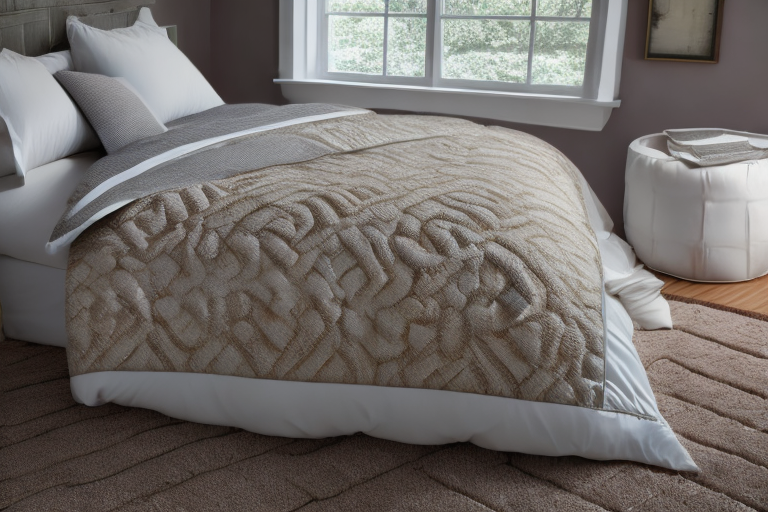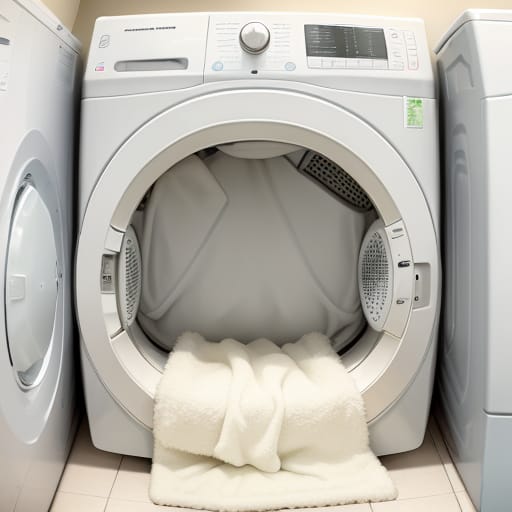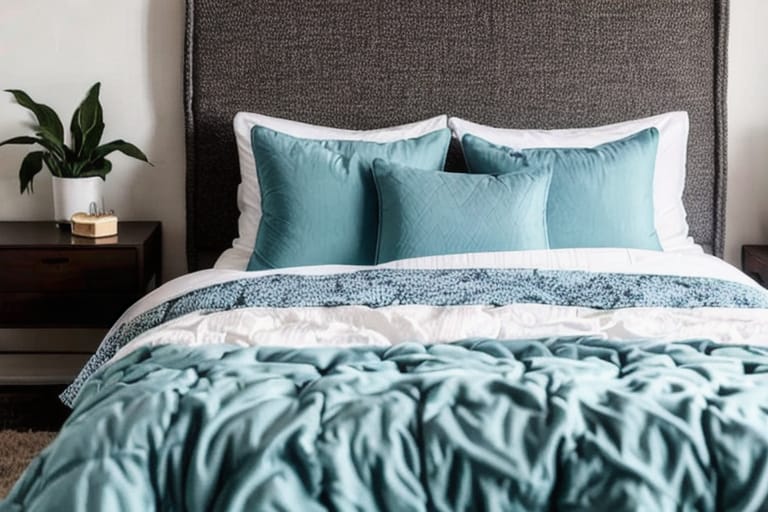When it comes to your comforter, getting the right warmth for your needs is key for a good night’s sleep. But down alternative comforters come with some common misconceptions – namely, that they run notoriously hot. While some are certainly toastier than others, the reality is down alternatives run the gamut for temperature regulation. Understanding the different factors at play is essential to find one with your ideal comfort zone.
This beginner’s guide breaks down everything you need to know about down alternative warmth and cooling capabilities. You’ll learn how fill materials, construction methods, fabrics, and more impact heat retention and airflow. We suggest the best options for warm, cool, and middle-of-the-road sleepers needing an adjustable temperature comfort range. Plus we cover care, cost comparisons, and tips for layering bedding.
So don’t sweat your comforter choice (pun intended)! With this advice you can drift off into luxuriously cool and cozy slumber.
How Down Alternatives Work to Control Temperature
Down alternative comforters are filled with synthetic materials to mimic qualities of natural goose or duck down fill. The most common ones are:
- Polyester fiberfill – Made of PET plastic pellets that cluster together to trap body heat. The most affordable option.
- Microfiber fill – Extremely fine synthetic fibers that feel soft and pack well for insulation.
- Hollow silicone microfibers – Filled with air for lightweight body-contouring warmth.
Unlike feather and down clusters, synthetic fibers do not collapse when compressed. This allows down alternative comforters to spring back to a fuller shape and distribute fill evenly across your bed.
Many down alternative options also integrate special temperature-regulating technologies for breathability:
- Phase change materials (PCMs) – Store and release heat to maintain optimal temperature.
- Moisture-wicking fabrics – Pull sweat away from your body so you don’t overheat.
- Airflow pockets between fiber clusters.
This means synthetic fill offers reliable warmth while sleeping cool. Well-designed down alternatives give you the best of both worlds!
Factors That Impact Down Alternative Warmth
Down alternative comforters have a wide range of thickness and insulation abilities. The level of toastiness comes down to four key factors:
1. Fill Material
- Polyester provides the most warmth since it’s dense and tightly-packed.
- Microfibers feel medium in warmth with softness.
- Light, fluffy silicone microfibers offer warmth without heaviness.
2. Construction
- Baffle box comforters have fabric walls dividing fill into sections for even distribution. This prevents cold spots and retains more body heat.
- Sewn-through comforters stitch the whole face together. Fill can shift around and air flows through the seams more freely. So these tend to sleep cooler.
3. Fabric Cover
- Cotton shells are lightweight and breathable.
- Microfiber covers add an insulating layer to seal in warmth.
- Innovative covers like Tencel lyocell utilize fabric weave to actively pull heat and moisture away from your body.
4. Fill Power
Higher fill power indicates more loft (fluffiness). This leaves more air pockets for better circulation. Compare:
- Low-fill comforters feel heavier and warmer.
- High-fill comforters feel lighter with more airflow.
Now let’s explore your options to pinpoint the right balance of cozy and cool for your needs.
Finding the Best Comforter for Warm Sleepers

Sleeping hot and throwing off covers? You need a comforter that expertly whisks away excess body heat. Here are the best cooling features to look for:
- Moisture-wicking, breathable covers like Tencel lyocell or eucalyptus
- Lightweight fills like silk, bamboo or hollow microfibers
- Generous baffle boxes to prevent fill shifting
- Sewn-through construction for maximum airflow
- Medium to high fill power around 600+ fp
With these specs, you get cloud-like snugness without breaking a sweat. Two great options are:
Buffy Breeze Comforter
- Cover: Soft Tencel lyocell pulls moisture away
- Fill: Fluffy eucalyptus fibers and recycled PET fill
- Features: Baffle box construction, 700 fp
- Price: $170-$190
COZSINO Cooling Comforter
- Cover: Bamboo rayon cover wicks away moisture
- Fill: Silky hollow microfibers trap cool air
- Features: Breathable sewn-through style, 400 fp
- Price: $47-$67
Finding the Best Comforter for Cold Sleepers
Do you sleep bundled under mounds of blankets? Then you likely need a comforter with serious insulation power. Ideal features include:
- Heavyweight polyester fiberfill
- Tightly-woven microfiber shell
- Generous baffle boxes to prevent shifting
- Low fill power density, around 300 fp
- Thicker quilt stitching with minimal through-seams
Two indulgently cozy options are:
Utopia Bedding Comforter Duvet Insert
- Shell: Soft brushed microfiber
- Fill: Luxe polyester fill hypoallergenic
- Features: Baffle box construction, 400 fp
- Price: $30-$50
LINENSPA All-Season Down Alternative Quilt
- Shell: Smooth microfiber with corner duvet tabs
- Fill: Plush microfiber fill avoids cold spots
- Features: Box stitch to seal in warmth, 350 fp
- Price: $30-$60
Finding an Adjustable, All-Season Comforter
Not too hot, not too cold…juuust right. Like Goldilocks, all-season comforters give you the best of both worlds for year-round comfort. Flexible features to allow temperature adjustments include:
- Mix of lightweight AND heavyweight materials – balances insulation with breathability
- Medium fill power density around 500-600 fp
- Quilted mix of baffle box and sewn-through panels
- Light cotton cover with cozy microfiber backing
- Corner tabs to add or remove a duvet as needed
COZYMAKER All Season Hypoallergenic Quilt
- Shell: Soft cotton top with cozy microfiber back
- Fill: Recycled hypoallergenic microfiber
- Features: Mixed construction, 550 fp, corner tabs
- Price: $65-$95
How to Adjust Your Comforter by Season
| Season | Adjust This Way |
|---|---|
| Summer | Use a lightweight cover like cotton or linen, remove duvet cover |
| Spring/Fall | Layer underneath with a light blanket or top sheet |
| Winter | Add a cozy duvet cover and/or blanket on top |
Easy Care and Durability of Synthetic Comforters

Unlike feather and down bedding, down alternative comforters are conveniently machine washable. Look for ones clearly labeled:
- Machine wash gentle cycle with cold water
- Tumble dry low heat or air dry flat
- Use a mild detergent without fabric softeners or bleach
Washing every 2-3 months keeps your comforter fresh. Polyester and microfiber fill are extremely durable for years of daily use.
For price comparisons, machine-washable down alternative comforters range from:
- Budget ($30 to $100)
- Mid-Range ($100 to $200)
- Luxury ($200 to $500+)
Within each category both quality and value for money can vary widely. Focus on specs like construction method and warmth ratings rather than price alone.
Eco-Friendly Sustainable Fill Materials
For guilt-free green bedding, look for down alternative comforters with sustainably-sourced, recycled materials. Popular options include:
- Plastic water bottles recycled into polyester fill – Keeps trash from landfills and oceans
- Eucalyptus and Tencel lyocell covers – Made from fast-growing eucalyptus trees requiring minimal water and pesticides
- Recycled cotton covers – Repurposes fabric scraps to reduce textile waste
- HydroCool and Climate Pledge Friendly certification – Ensures environmentally-safe production methods
An excellent green example is:
Buffy Cloud Recycled Bottle Comforter
- Shell: Soft recycled cotton
- Fill: Recycled PET fill from plastic bottles
- Features: Climate Pledge Friendly certification
- Price: $160-$180
Finding the Right Comforter Size
One often-overlooked factor for optimal comfort is getting the right comforter size. General guidelines:
- Choose your regular mattress size (twin, full queen, king etc.)
- For a generous overhang, size up (ex. choose a king comforter for a queen bed)
- If using a duvet, select a cover size smaller than your comforter for a snug fit
- Look for corner tabs to securely attach a duvet cover
Measure your mattress length and width. Then reference a detailed comforter size chart guide to match up dimensions. Oversized is better than undersized for full coverage without pulling or shifting in the night.
Enjoy Allergy Relief from Synthetic Fill
Alongside regulation and care benefits, down alternative comforters are hypoallergenic. This makes them ideal for those with sensitivities. Key advantages over feather and down include:
- Resistant to dust mites which trigger allergies and asthma
- Non-allergenic synthetic fill unlike bird proteins
- Machine washable for easy and effective allergen removal
If you suffer from congestion, sneezing, or watery eyes in bed, synthetic comforters are the way to go. Many feature antimicrobial treatments to deter mold, mildew and bacteria for a fresh night’s sleep.
Special Considerations for Different Sleepers
Everyone has unique sleep temperature preferences. Here are considerations based on your sleep habits and symptoms.
Warm Sleepers and Night Sweats
- Need advanced sweat-wicking technology like Tencel lyocell
- Avoid heavyweight shells or fills
- Use cooling sheets underneath
- Keep bedroom around 65 Fahrenheit
Cool Sleepers
- Choose a quilted microfiber shell over lightweight cotton
- Polyester or microfiber fill retains most warmth
- Use flannel sheets underneath
- Keep bedroom 68-72 Fahrenheit
Sensitive Pressure Points
- Softer, highly breathable fills relieve pressure
- Baffle boxes prevent fill bunching up
- Medium loft around 500 fp feels “cloud-like”
- Avoid very thick or overly stuffed comforters
Add Layers for Custom Comfort
Your optimal sleep setup likely includes more than just a down alterative comforter. Adding other strategic layers gives you customizable warmth and breathability.
Matched Duvet Cover Set
Choose a duvet cover with sheets made from the same fabric for seamless temperature control.
Blankets and Bed Throws
Layering blankets under or over your comforter gives quick warmth adjustability.
- Fleece and wool blankets add winter insulation
- Light, breathable throws help prevent summer overheating
Pillow Inserts
Too many pillows can cause heat and sweat buildup around your head, neck and shoulders. Stick to 1-2 pillows maximum.
The Beauty of Down Alternative Comforters
Beyond practical temperature regulation, down alternative comforters offer aesthetically pleasing style with design flexibility surpassing down. With technological advancements in synthetic materials, many rival the heavenly cloud-like quality so desirable in bedding.
Unique advantages include:
- Extreme softness for sensuous luxury
- Beautiful patterns and colors like tie-dye unavailable elsewhere
- Intricate quilting adding depth, texture and visual elegance
- Custom shapes like round can be constructed
So you get that magnificent hotel bed beauty without paying big bucks.
Finding Your Goldilocks “Just Right” Comforter
At the end of the day, you want bedding giving you blissful sleep night after night. We covered all the objective specs and features at play. But determining your “just right” comforter also requires listening to your individual instincts.
Ask yourself:
- Which fabrics feel best against my skin?
- What level of warmth helps me drift off fastest?
- How hot is too hot or cold too cold for me?
- When I wake up, do I feel refreshed? Overheated? Chilled?
Track your sleep quality and adjust layers as needed. There is no universal perfect comforter or temperature, only what feels right for your singular sleep sanctuary. While sticking to science for informed decisions, ultimately let your personal preferences steer you toward restful slumber.
Summary and Conclusion
We hope this guide gave you clarity that down alternative comforters CAN properly regulate temperature for heavenly sleep. Getting the right construction and materials avoids the notorious heat misconception.
Here are the key points to takeaway:
- Light, breathable covers and fills maximize airflow and cooling
- Dense poly fill and microshells provide toasty warmth
- Innovations like moisture-wicking fabrics actively dissipate heat
- Proper sizing ensures nothing disrupts thermal efficiency
- Carefully reading labels prevents surprises in warmth or shrinkage
While striking that perfect balance between cozy and cool can be tricky, now you have all the tools to feel confident choosing a down alternative comforter aligned with your comfort zone.
Frequently Asked Questions
Are down alternative comforters hotter than real down comforters?
It depends on the materials and construction. Well-designed down alternatives integrate innovative cooling technologies real down lacks. But lower quality ones with poor breathability can sleep hotter. Compare quality and specs vs. assuming one is universally warmer.
Should I get baffle box or sewn-through construction in a down alternative comforter if I sleep hot?
Sewn-through down alternative comforters allow maximum airflow for cooling benefits. The stitching leaves spaces for air to circulate freely. Baffle box construction has walls dividing fill into boxes, which better seals in warmth.
What is the best down alternative fill for sleeping cool?
The most lightweight, breathable down alternative fills ideal for warm sleepers are:
- Hollow silicone microfibers with trapped cool air
- Fluffy eucalyptus fibers
- Airy bamboo rayon clusters
These feel cloud-like without heaviness trapping body heat.
Is a lightweight or heavy down alternative comforter better?
This depends on your warmth needs. Warm sleepers do better with ultra-lightweight down alternative comforters around 400 fill power. Cold sleepers needing insulation should choose heavyweight ones with dense polyester or microfiber filling closer to 300 fp.
How do I wash a down alternative comforter?
Check your comforter label, but most are conveniently machine washable. Use a gentle cycle with cold water and mild detergent. Either tumble dry low or air dry flat. Wash every 2-3 months.
What size down alternative comforter should I get?
Choose your regular comforter size matching mattress size, and size up if you want an overhang. So for a queen bed, opt for a queen or oversized king comforter. If using a duvet, choose a cover slightly smaller than comforter dimensions for a snug fit.








